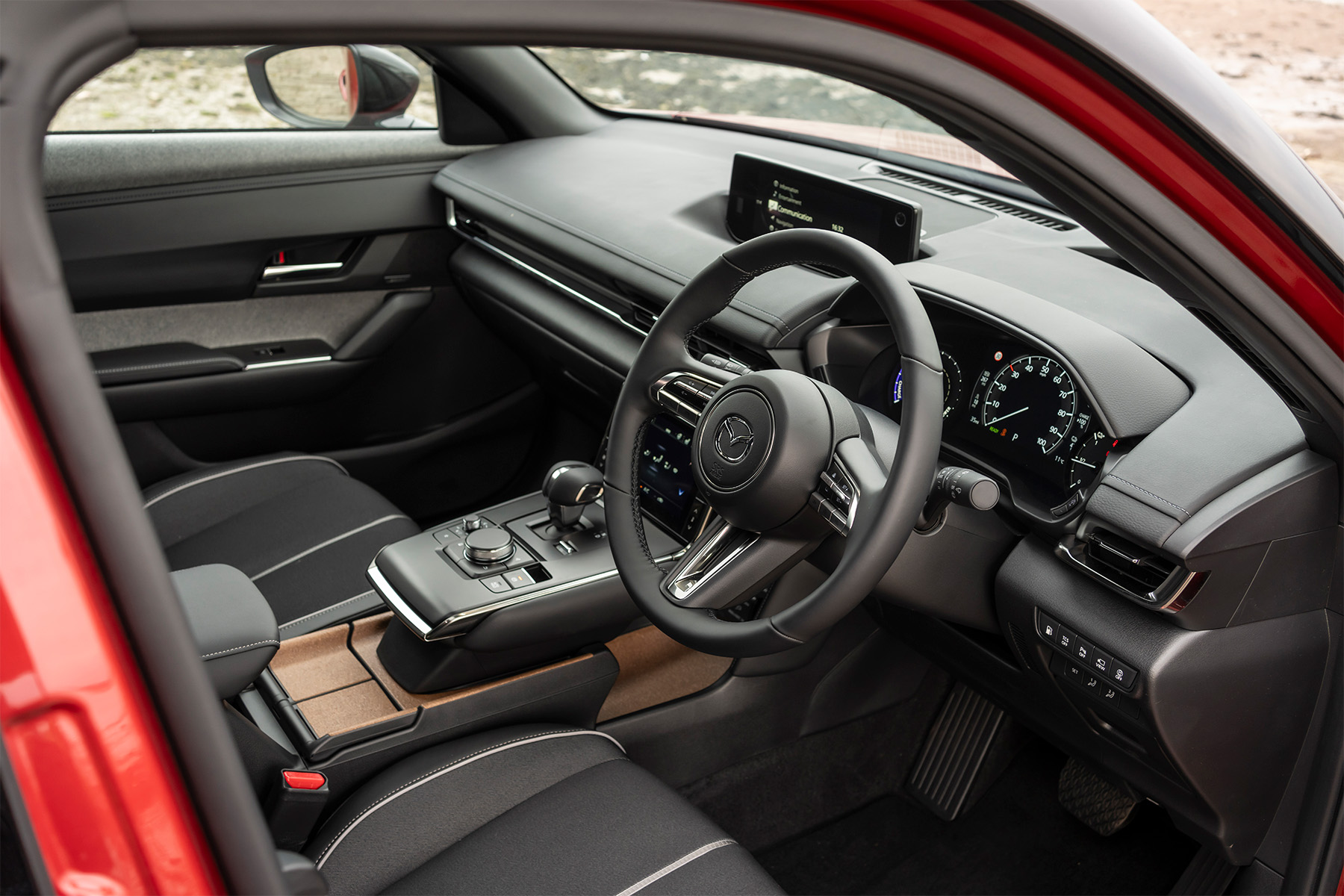Make and model: Mazda MX-30 R-EV
Description: Range-extender version of Mazda’s first electric SUV
Price range: £31,250 – £35,550
Mazda says: “The perfect solution for customers who want an electric car for everyday use but the flexibility to undertake longer journeys without reliance on charging infrastructure.”
We say: Looks good and is fun to drive, but removing range anxiety brings other compromises. A car of limited appeal.
Introduction
Mazda launched its first electric vehicle, the MX-30 SUV, in 2020 and as is typical of this brand went a different route to everyone else, targeting light weight and a better driving experience over outright range.
Generally the car has been well received, holding an Expert Rating of 61% as of November 2023, but the most significant criticism has been its poor battery range. Mazda says 124 miles is more than adequate for most buyers who won’t travel any further on a daily basis.
Potential customers, however, seem to have disagreed and the MX-30 is a rare sight on UK streets. Now, however the brand has provided another answer for critics of its range, by adding a petrol engine to its electric vehicle!
What’s new about this car?
This new variant of the Mazda MX-30 has only one new feature to speak of, but it’s a very significant one. The R-EV is not a purely battery-powered electric vehicle but a form of plug-in hybrid with a petrol engine added to the car. The ‘R’ in the title stands for Range Extender, and we explain what that means in more detail further below.
It’s still an electric vehicle in principle, since only the electric motor is used to drive the wheels. The petrol engine (and it’s no ordinary petrol engine) works as a generator to charge the battery when it runs out of electricity. This boosts the car’s potential driving range to nearly 400 miles.
How does it look?
The MX-30 scores in the visual stakes, with a coupe-like profile that is very far removed from a typical somewhat boxy SUV. All part, so we’re told, of creating a look that reinforces the fun-to-drive aspect. It’s even more aggressively raked than most so-called ‘coupé SUVs’, which is what the car’s designers were aiming for.
The biggest visual feature is the combination of a lack of central pillars and a pair of rear-hinged doors for back-seat passengers. That helps with the sleek looks, but it significantly impacts on the MX-30’s practicality as a family car.
You can’t open the rear doors without opening the fronts first, which will be endlessly irritating for owners who regularly have passengers jumping in and out of the rear seats. The rear-hinging design should mean very easy entry and exit of the car when the doors are open, but it doesn’t quite work out that way in practice.
We like: One of the sleekest looking SUVs around
We don’t like: Rear-hinged doors that can’t open before fronts

What are the specs like?
In terms of specification, the RE-V version of the Mazda MX-30 almost entirely replicates that of the all-electric models. So there are three trim levels, but they have been given snappy new names which the pure EV range has also adopted.
Now we have Prime-Line, Exclusive Line and Makoto – there was a limited edition launch model called Edition R but this sold out soon after it was announced. There’s no price penalty between BE-V or R-EV – both start at just over £31K, though unless you choose a white car you’ll be paying between £550 and £1,800 for one of the six exterior paint options.
Mazda has always been known for extensive standard equipment and all models include items formerly regarded as upper-level desirables, such as adaptive cruise control and a head-up display. Front and rear parking sensors and a reversing camera are fitted to all versions, as are navigation, Apple CarPlay and Android Auto smartphone capability and an extensive selection of active safety aids. These earned the MX-30 a five-star Euro NCAP safety rating when it was tested in 2020, a score which has been extended to the new R-EV version as well.
Exclusive-Line adds £1,900 to the cost and this pays for posher alloys and exterior detailing, heated front seats and power adjustment in multiple directions on the driver’s, and smart keyless entry.
Finally there is the top-level Makoto, costing from £35.5K and gaining a powered tilting and sliding sunroof, 360-degree view monitor, an uprated Bose sound system with 12 speakers, de-icing on the wipers and heating on the steering wheel, and additional active safety aids.
There is one additional and useful feature on the Makoto that the all-electric versions don’t have – ‘Vehicle to Load’. A three-pin plug socket is fitted allowing one to use the car’s battery energy to power a separate electric appliance, such as a lighting system or cooker whilst camping. If the battery becomes depleted while in use for this, the engine will cut in to recharge it just as it does when on the road.
We like: Amount of equipment including strong safety package
We don’t like: Very limited body colour choice without paying more
What’s it like inside?
The MX-30 recalls Mazda’s RX-8 sports car made between 2002 and 2012 in the form of its rear-hinged back doors and lack of central pillar. Previous cars built this way have emphasised the way they open up the entire side of the car making it very easy to get in and out.
Sadly this is not the case for rear-seat passengers in the MX-30. Tall people will struggle to get in and, once installed, find themselves with not much room (also much like the RX-8!). It’s not very bright either, thanks to the small coupe-style windows, unless you go for the top-spec Makato model with its standard-fit sunroof.
The front half of the cabin is far more spacious, and the driver will appreciate the sensible layout of the controls and the high-mounted sat-nav screen atop the centre console.
The eco-friendly talking points debuted with the B-EV continue in the new model, including realistic looking artificial leathers and cork trim made out of the waste from bottle-stopper production, recalling Mazda’s earliest days as a cork manufacturer. Mind you, some of the finishes are slightly odd in colour – one appearing a bit like a rust shade – but generally the cabin feels of high quality.
Boot space also takes a hit from the addition of a petrol engine, down to 350 litres (compared to 366 litres in the electric-only MX-30). Other small SUVs offer more.
We like: Quality of fit and finish
We don’t like: Cramped rear seat space, reduced boot space


Under the bonnet
First a quick recap – Mazda justified the limited 124-mile range between charges of the full-electric MX-30 by arguing that few people travel a long way on a daily basis. Therefore a more responsive EV with particularly a lighter battery (the MX-30’s battery pack is claimed to be about half the weight of a typical EV’s) will be much more fun to drive and use much lower amounts of rare-earth minerals in its construction.
This view attracted some criticism, which appeared to wash over the designers who responded that the MX-30 is not a car for everyone. But now we have this new plug-in hybrid version, adding a small petrol engine which is only present to generate energy for the battery when needed – said engine has no connection with the wheels.
As you might expect with Mazda, the combustion element is anything but ordinary. Instead it marks the return of the rotary engine technology that the Japanese brand has persisted with for many years – and another connection between the MX-30 and the RX-8 sports car.
Rotary engines are very different beasts to typical petrol units, being naturally small (this one is just 0.8 litres, which is about half the capacity of a conventional engine), light in weight and exceptionally smooth in operation – ideal for this application.
This energy generation is vital as the battery range of the R-EV drops from the 124 miles of the all-electric model to just 53 miles, basically because the battery is much smaller again. This means the MX-30 R-EV is much more like a plug-in hybrid car, even though the mechanics under the bonnet work quite differently.
That range might not sound a lot at all, but again for many owners commuting daily to their place of work and charging overnight it will be perfectly adequate, with the internal combustion backup there if a sudden dash across half the country is required or desired. Mazda’s own research suggests the daily mileage clocked up by users of their cars averages out at around 26 miles a day, while government figures quote average distances travelled of 100 miles a week.
The R-EV also offers a range of driving modes – ‘normal’ sees the car running on electric power until the battery charge drops under a percentage that the driver can set (anything from 20 to 100% charged), at which point the engine will wake up and start recharging.
In ‘Charge’ mode the engine will be alive all the time charging the battery, for such occasions when one needs the car to be electric only, when it can be switched to EV mode. The system is clever too – for example, accelerate hard and the engine will immediately cut in to aid battery power and maintain the swift pace.
One other positive of having a very small battery is that it takes less time to charge. A typical 7kW home charger will provide a full refill in under two hours, while an 11kW charger takes 50 minutes. Unlike many plug-in hybrids, the R-EV also offers DC rapid charging capability, a 36kW charger taking the battery from 20 to 80% in 25 minutes, or in other words a coffee stop…
How does it drive?
When we drove the all-electric MX-30 back in 2021, we were impressed by its driving performance, Mazda’s ‘light weight means better handling’ claim being completely borne out – it felt swift despite a ten-second 0-62mph time, and boasted excellent handling with progress along twisty country roads more akin to a sporty saloon than SUV.
The R-EV does everything its all-electric sister does, just a little bit more rapidly, cutting just over half a second off the 62mph sprint. It retains the cornering prowess, helped by the fact that both versions use the latest version of Mazda’s electronic chassis assistant, which can moves the grip bias from front to rear to better control the G-forces.
Just like the battery variant, the R-EV offers an extensive regenerative braking function, which the driver can adjust using using paddles behind the steering wheel.
There is one major oddity when driving this car, however, the point where the engine wakes up to do its thing. The cut-in is so smooth you don’t feel it, but you do then become aware of a low but mildly irritating constant buzz – because the rotary unit is not connected to the wheels and therefore does not vary in its load, the note never changes…
One more thing – it’s important to plug the R-EV in whenever possible, rather than simply using the engine. Do the latter and, on the evidence of our test drive, you’re looking at fuel economy of less than 40mpg, which is worse than most petrol-powered small SUVs.
We like: Drive modes that make most efficient use of electric power and energy recovery
We don’t like: Sound of the range-extender, a not too loud but annoying constant buzz


Verdict
Mazda does not expect the R-EV to take that big a slice of MX-30 sales. The car is a somewhat niche model anyway and the brand insists that, for most owners, the full electric version’s modest range will still be more than sufficient for day-to-day use.
So this is a newcomer for a very specialist audience – those who like the different way that Mazda goes about doing EVs, but who need to travel longer distances on occasion. If this sounds like you, and you don’t need to carry passengers in the back very often, then the MX-30 R-EV could be worth a look.
MX-30 R-EV highlights
- Range-extender engine removes any range anxiety
- Looks sporty for an SUV
- Quality build
- Versatile options for charging and using electric power
MX-30 R-EV lowlights
- Cramped rear space
- Rear doors can’t be opened without fronts
- Adding engine cuts electric-only range in half
- Engine note not the best
Similar cars
Citroën ë-C4 | DS 3 Crossback E-Tense | Hyundai Kona Electric | Kia Niro EV | Kia Soul EV | Mini Countryman plug-in hybrid | MG ZS EV | Nissan Leaf | Peugeot e-2008 | Vauxhall Mokka-e | Volkswagen ID.3 | Volvo XC40 Recharge
Key specifications
Model tested: Mazda MX30 RE-V Makoto
Price (as tested): £37,700
Powertrain: Single electric motor plus petrol generator
Battery: 18 kWh
Power: 170 hp
Torque: 260 Nm
Top speed: 87 mph
Acceleration (0-62mph): 9.1 seconds
Buy a Mazda MX-30 R-EV
If you’re looking to buy a new or used Mazda MX-30, The Car Expert’s partners can help you find the right car
Discover great deals available on both new and used cars. Find out more

Search for your next new or used car with Auto Trader. Find out more
Buy a car online from your sofa. We’ll deliver it. Find out more
Search less, live more. We make finding the right car simple. Find out more
Lease a Mazda MX-30 R-EV
If you’re looking to lease a new Mazda MX-30, The Car Expert’s partners can help you find a competitive deal
Subscribe to a Mazda MX-30 R-EV
Subscriptions are becoming a very popular way for consumers to try an electric car for a few weeks or months to help decide whether it’s a suitable alternative to a petrol car. If you’re interested in a car subscription, The Car Expert’s partners can help. (PS: What’s a car subscription?)







